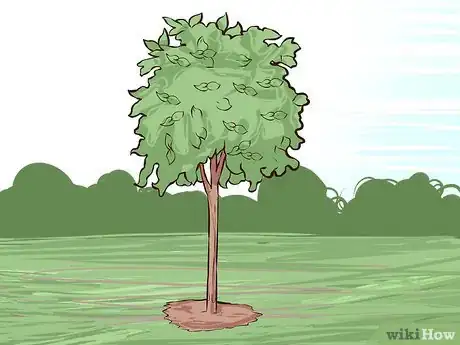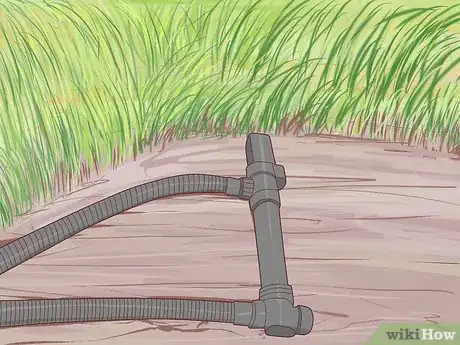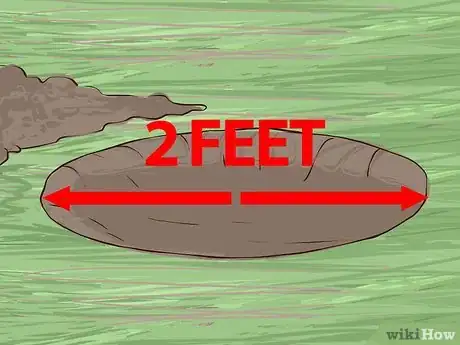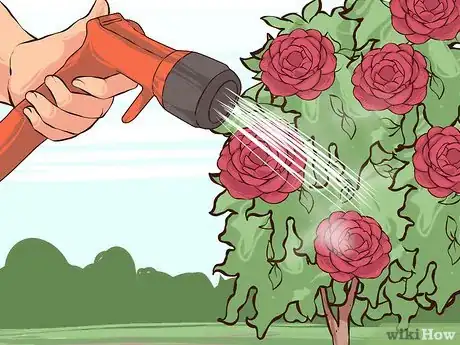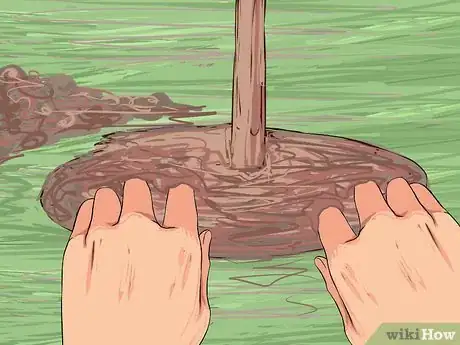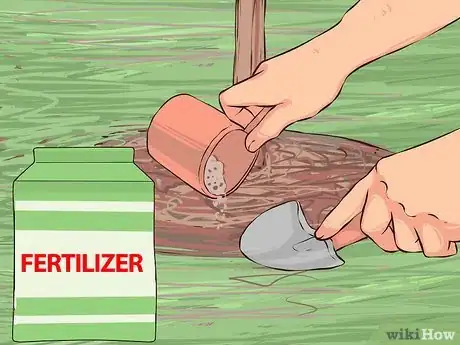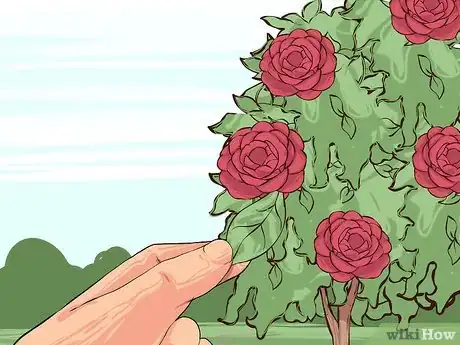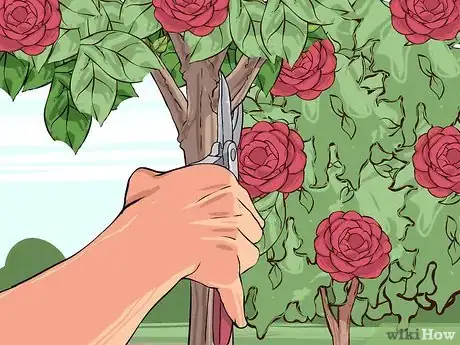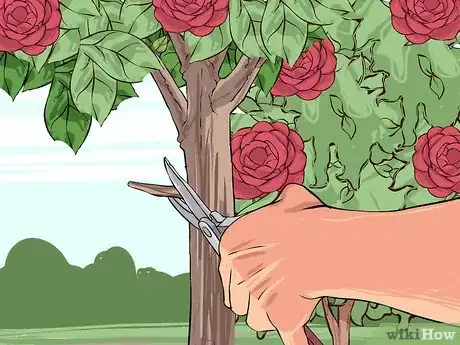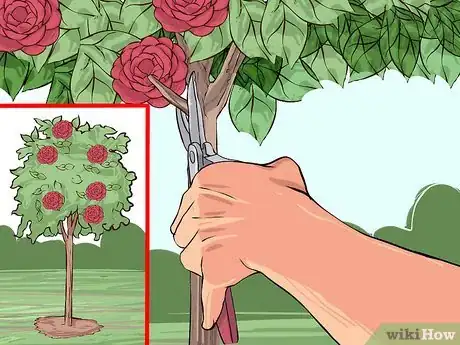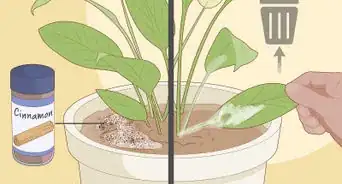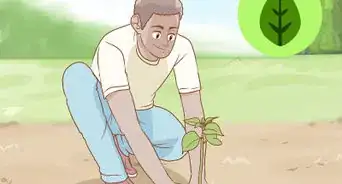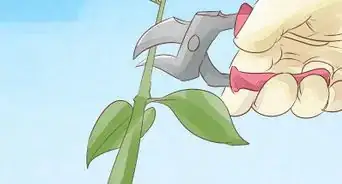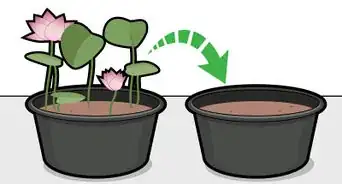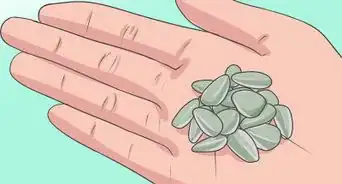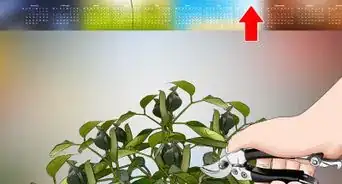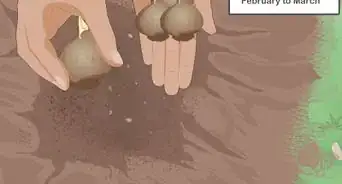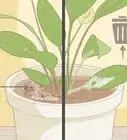This article was co-authored by Katie Gohmann. Katherine Gohmann is a Professional Gardener in Texas. She has been a home gardener and professional gardener since 2008.
There are 11 references cited in this article, which can be found at the bottom of the page.
wikiHow marks an article as reader-approved once it receives enough positive feedback. In this case, 91% of readers who voted found the article helpful, earning it our reader-approved status.
This article has been viewed 158,734 times.
Camellias are an old-fashioned flower much beloved in many gardens. They come in a wide variety of colors and varieties that are hardy in USDA Zones 7-10. Once planted, it's important to tend them to ensure that they continue to bloom beautifully every year. Caring for your camellias includes proper feeding and watering, as well as proper pruning and maintenance.
Steps
Planting Camellias
-
1Plant in light shade. This is a golden rule. Camellias do best in light shade that protects them from hot afternoon sun.[1] This doesn't mean that they need total shade, just enough so that they don't bake in the sun.
- As a camellia grows, it can tolerate more sun. This is because a mature camellia will have a big canopy of leaves that will shade the roots and make sure they don't get too dried out by the sun.
- This also depends on what climate you are planting the camellia in. If you are in a climate that never gets very hot, then a camellia can cope with a spot with less shade.
-
2Ensure your site has good drainage. Camellias can't stand having “wet feet” and must have well-draining soil.Advertisement
-
3Keep camellias out of the path of wind. The more sheltered the camellia, the better the flowering will be. This is because the dehydration from winds any time of year can kill camellias, whether it be warm winds in the summer or cold winds in the winter.[2]
- Try planting your camellia between 3 to 6 feet from your house. This will give it good protection from the wind.
- If you need to, erect a fence or trellis to divert direct wind away from your camellia plants.
- The lighter the flower color, the more protection from wind is needed.
-
4Planting the camellia. Dig a hole that is two feet wider than the root ball of the plant. The hole should be just a bit deeper than the root ball in the center but a few inches deeper than that around the edges. Keeping the hole shallow in the center will prevent the plant from sinking.[3] Digging the hole deeper around the edges will give the plant's roots some looser soil to easily spread out into.
- Place the rootball in the hole, making sure the top is slightly above the soil level. It's important to keep the rootball 2–4 inches (5.1–10 cm) above the soil line because camellias are sensitive to being planted too deeply.[4] Fill the rest of the hole with a mixture of top soil and organic material.
- Press the dirt around the plant down so that it is firmly in place. Slope the dirt up the sides to meet the top of the rootball, but don't cover the rootball with any soil.
- Then give the plant a deep watering. If the weather is dry, give a new plant a thorough watering every week until it is well established.
Caring For Camellias
-
1Use deep watering. Camellias love deep watering about twice weekly, rather than daily shallow watering. This is partially because camellias love generally moist soil as opposed to soggy soil. Giving a deep soak allows the soil to have a generally moist consistency for longer.
-
2Mulch around your camellia. Mulching will help keep moisture in the ground and it will keep the soil cooler on hot summer days. In addition, mulch will help keep weeds at bay.[5]
- Use whatever mulch you have readily available but don't pile it more than a few inches high, no matter what you use. This can keep soil too wet and lead to root rot.
- Remember that the mulch should not touch the trunk of the plant.[6]
- Mulch also adds new organic material to your soil. This will help to break up clay soil or add richness to sandy soil. In general, it will increase the quality of your top soil tremendously.
-
3Apply a suitable fertilizer every spring. Some Camellias are considered heavy eaters, meaning that they need a lot of nutrients from the soil in order to thrive. This will ensure lush growth and good flowering each season.
- There are other varieties too, where the plant is not a heavy feeder, and do not react well to over-stimulation.[7]
- Do not fertilize after August. Interestingly, their bloom time is also their dormant period and so should not be fertilized then.[8]
- Cottonseed meal and fish emulsion are good natural choices. Two or three feedings between April 1 and September 1 is all that is necessary.[9]
- Contact your local extension service or camellia experts to get recommendations of fertilizers that work well in your specific area and for your specific variety of the plant.
- Fertilizers usually have three numbers on them, which tells you about the nutrients in it. The first number is for nitrogen, the second number is for phosphorus, and the third number is for potassium.[10]
- If you want your camellia to increase in size because it is newly planted, give it a fertilizer with a larger first number, such as 10 or 12.
- If you just want to maintain the size of an already established plant, then a lower first number, such as 4, will work well.
-
4Don't overdo the acid. There is a common perception that camellias are acid-loving. The reality is that camellias prefer slightly acidic conditions but they do not like very acidic conditions. If you've been overdoing the acidic fertilizing, stop now!
-
5Look for infestations.
- Check the top and the underside of the leaves weekly for aphids and spider mites. When you spot an infestation, rinse off the insects with a strong stream of water.
- Check the woody stems for scale insects. Scale appears as raised welts that scrape off easily. Spray scale with a ready-mixed all-season horticultural oil.[13]
Pruning Camellias
-
1Prune right after blooming. If you prune right after blooming then you will give the plant time to rejuvenate and grow new buds for the following spring. There is a good period of dormant time between when the plant blooms and when it starts to sprout new growth for you to do this.[14]
- Pruning at other times of year will not kill a well-established plant. However, it will eliminate your buds for the following spring, so prune off season carefully.
-
2
-
3Shape bushes to your liking. To begin with, remove leggy or lanky branches that stick out and don't look good. Then prune for general shape. Pruning should also be done to shape the plant so it fits into your landscape. This may mean a light or severe pruning, depending on the shape of the camellia and how long it has been left to grow untended.
- Severe pruning means removing one third to one half of the plant. This should be done without fear of losing the plant, as most camellias are very strong and will outlive those that planted them. However, the year following a severe pruning you will probably have fewer blooms, as the plant is focused on regrowing its branches and leaves.[17]
- Light pruning can be done with small hand shears or larger shaping shears. You will get a cleaner look if you prune individual branches, as opposed to cutting large swaths with shaping shears.
Expert Q&A
Did you know you can get expert answers for this article?
Unlock expert answers by supporting wikiHow
-
QuestionMy camellia has never bloomed and is 7 yrs old. What am I doing wrong?
 Katie GohmannKatherine Gohmann is a Professional Gardener in Texas. She has been a home gardener and professional gardener since 2008.
Katie GohmannKatherine Gohmann is a Professional Gardener in Texas. She has been a home gardener and professional gardener since 2008.
Professional Gardener If your plant isn't blooming, it isn't happy. Check everything: make sure the soil is acidic enough (pH of 5.5-6.5), make sure you have adequate drainage (camellias hate to stand in water), make sure your camellia is in partial shade (too much sun can prevent flowering), check to see if there are any pests that need to be removed, give it some fresh compost, mulch, and acidic fertilizer every spring, and see if that helps.
If your plant isn't blooming, it isn't happy. Check everything: make sure the soil is acidic enough (pH of 5.5-6.5), make sure you have adequate drainage (camellias hate to stand in water), make sure your camellia is in partial shade (too much sun can prevent flowering), check to see if there are any pests that need to be removed, give it some fresh compost, mulch, and acidic fertilizer every spring, and see if that helps. -
QuestionWhy are the flowers dropping off my camellias?
 Katie GohmannKatherine Gohmann is a Professional Gardener in Texas. She has been a home gardener and professional gardener since 2008.
Katie GohmannKatherine Gohmann is a Professional Gardener in Texas. She has been a home gardener and professional gardener since 2008.
Professional Gardener Do you mean the buds, or the flowers? The flowers will drop after they have opened and run their course. It's normal. It's also normal to lose a few buds, but if you have a ton of buds dropping and no flowers opening up, it could be over- or under-watering or sudden cold temperatures. Take a look at http://www.monrovia.com/how-to-grow-camellias/ for some more information.
Do you mean the buds, or the flowers? The flowers will drop after they have opened and run their course. It's normal. It's also normal to lose a few buds, but if you have a ton of buds dropping and no flowers opening up, it could be over- or under-watering or sudden cold temperatures. Take a look at http://www.monrovia.com/how-to-grow-camellias/ for some more information. -
QuestionWhat can be done for a healthy plant that is not flowering?
 Community AnswerIt may not be getting the proper nutrients. This could be in the form of minerals, or sunlight, either too little or too much. Get a soil test kit and make sure the soil surrounding the plant is appropriate for it. Fertilizer regularly with a balanced fertilizer.
Community AnswerIt may not be getting the proper nutrients. This could be in the form of minerals, or sunlight, either too little or too much. Get a soil test kit and make sure the soil surrounding the plant is appropriate for it. Fertilizer regularly with a balanced fertilizer.
Warnings
- A harsh winter can cause the camellia tips to go brown. If this happens the buds either won't bloom or will be poor in quality.⧼thumbs_response⧽
References
- ↑ http://www.southernliving.com/home-garden/gardens/camellias
- ↑ http://cspv.org/camellia-care/camellia-care-winter-protection/
- ↑ https://www.americancamellias.com/care-culture-resources/general-culture-requirements/planting-camellias
- ↑ http://www.monrovia.com/how-to-grow-camellias/
- ↑ https://www.americancamellias.com/care-culture-resources/general-culture-requirements/watering-camellias
- ↑ http://www.todayshomeowner.com/how-to-grow-camellias/
- ↑ http://www.growingagreenerworld.com/basics-of-growing-camellias/
- ↑ http://www.growingagreenerworld.com/basics-of-growing-camellias/
- ↑ http://www.growingagreenerworld.com/basics-of-growing-camellias/
- ↑ https://www.americancamellias.com/care-culture-resources/general-culture-requirements/camellia-fertilization
- ↑ https://www.americancamellias.com/care-culture-resources/general-culture-requirements/camellia-fertilization
- ↑ http://homeguides.sfgate.com/grow-camellias-pots-96657.html
- ↑ http://homeguides.sfgate.com/grow-camellias-pots-96657.html
- ↑ http://articles.latimes.com/1990-03-11/realestate/re-45_1_pruning-techniques
- ↑ https://www.americancamellias.com/care-culture-resources/general-culture-requirements/pruning-camellias
- ↑ https://www.americancamellias.com/care-culture-resources/general-culture-requirements/pruning-camellias
- ↑ https://www.americancamellias.com/care-culture-resources/general-culture-requirements/pruning-camellias
About This Article
To care for camellias, water them deeply twice a week so that the soil stays moist for longer periods of time. Additionally, mulch the ground around the base of the camellia to keep the ground moist and keep weeds away, making sure that the mulch isn’t actually touching the trunk in order to prevent root rot. Each spring, apply cottonseed meal to fertilize the plant, since camellias are heavy feeders and need a lot of nutrients. After the plant has bloomed, trim off any dead or dying branches to reinvigorate it and make it more resistant to disease. For advice from our Horticultural reviewer on the best places to plant camellias, keep reading.
